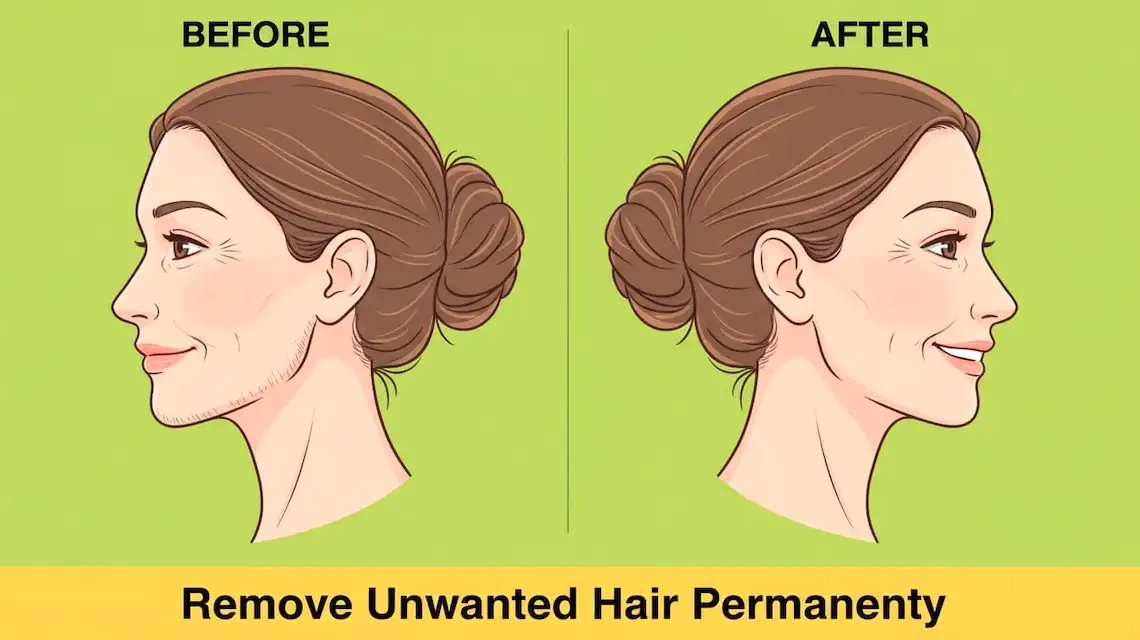Tired of shaving stubble? Wondering what “permanent” really means for hair removal? Here is the honest answer. The only method the FDA recognizes for permanent hair removal is electrolysis. Laser hair removal, and IPL devices, give long-term reduction that can feel close to permanent for many people, especially on large areas with dark hair. If you came here asking how to remove unwanted hair permanently, you will get a simple plan that matches the best method to your skin tone, hair color, body area, and budget.
Safety, cost, and time matter. You want smooth skin without burns, dark marks, or wasted money. This guide will help you set expectations, pick the right tool, and avoid common mistakes. When in doubt, book a consult with a licensed professional who treats your skin type often.
How to remove unwanted hair permanently: what really works
What permanent means vs permanent reduction
Permanent hair removal means the follicle is destroyed so it cannot grow again. Electrolysis reaches the growth cells in each follicle and shuts them down for good. It treats one follicle at a time, which is why it is precise and slow.
Laser and IPL cause permanent hair reduction. They heat the pigment in the hair, which damages many follicles so they produce fewer, finer hairs. Results can last years, and many people only need rare touch-ups. Since hair grows in cycles, every method needs a series of sessions to catch hairs in the active growth phase. Expect a staged process, not an overnight fix.
Quick overview of options: electrolysis, laser or IPL, and medical support
Electrolysis works on all hair and skin colors, including white and gray. It is ideal for small or scattered hairs, but it takes time for large zones.
Laser is the fastest choice for large areas with dark hair. It covers more follicles per pulse and can clear a back or legs much faster than electrolysis.
IPL is a broad-spectrum light that behaves like laser, but with less focus. It can be effective in skilled hands, though it may need more sessions.
Medical support helps if hormones drive new growth. Hormonal birth control, antiandrogens, and topical eflornithine can slow growth, especially on the face.
Safety basics by skin tone and hair color
Laser targets pigment, so dark hair responds best. Very light, red, or gray hairs usually do not absorb enough light, so electrolysis is the better pick. Darker skin tones can have safe, effective laser treatments with the right device and settings. Provider skill matters more than any single brand.
Sun care is nonnegotiable. Tanned skin increases burn risk and raises the chance of dark marks after treatment. Use SPF daily, avoid tanning before and after sessions, and follow aftercare closely.
Who should talk to a doctor first
See a clinician if you notice sudden or fast hair growth, irregular periods, acne, deep voice changes, or scalp hair thinning. Common causes include PCOS, thyroid disorders, and certain medicines like steroids or some anti-seizure drugs. Treating the cause can improve results and reduce new growth. Pause most hair removal treatments during pregnancy, and review your medications before you start any light-based procedure.
Electrolysis: the only FDA-approved permanent hair removal
How electrolysis destroys the follicle at the root
Electrolysis uses a tiny, sterile probe that slides into the follicle alongside the hair. Energy is delivered to the base to destroy the growth cells. There are three methods: galvanic (chemical reaction), thermolysis (heat), and blend (both together). Only hairs in the active growth phase are fully destroyed, so repeat visits are needed to treat hairs as they cycle.
Best candidates and body areas
Electrolysis works on every skin tone and hair color, even white, gray, red, and very light blond hair. It is ideal for small or precise zones like the upper lip, chin, sideburns, fingers, toes, and nipples. It is also helpful for shaping brows and cleaning up stray hairs after laser. If you have a few coarse hairs on the chin or a stubborn mustache line, electrolysis gives clean, lasting results.
Sessions, timeline, pain control, and aftercare
Sessions usually run 15 to 60 minutes. Most people start weekly or every other week, then space out sessions as growth slows. Facial hair can take several months to over a year for full clearance, depending on density, hormones, and how often you go. Pain control helps. Options include numbing cream, ice before and after, slower speeds, or more frequent short visits.
Aftercare is simple. Keep the area clean, skip heat and heavy sweating for 24 to 48 hours, avoid makeup on treated skin for a day, apply SPF daily, and do not pick. Small scabs and redness can be normal. Let them heal to prevent marks.
Cost, risks, and how to pick a qualified electrologist
Pricing varies by city and experience. Many clinics charge per minute or per session. Expect about 1 to 3 dollars per minute in many areas, and higher in large cities. A 15 minute session might be 30 to 60 dollars, while an hour can be 75 to 200 dollars or more. Total cost depends on the number of hairs and your goals.
Risks include redness, swelling, small scabs, temporary dark or light spots, and, rarely, scarring. To choose well, ask about licensure or certification, sterile technique, disposable probes, and gloves. You should get clear aftercare instructions. Book a short test session to see how your skin responds and to gauge comfort.
Laser hair removal and IPL: long-term reduction that can feel permanent
How laser hair removal works and common devices
Laser hair removal uses selective heating. Light energy seeks the pigment in the hair bulb, turns to heat, and disables the follicle. Common devices include diode and alexandrite for lighter skin, and Nd:YAG for darker skin because it penetrates deeper and is less absorbed by skin pigment. IPL is not a true laser. It uses broad light with filters and can be effective with proper settings and skill.
| Device type | Best match | Notes |
|---|---|---|
| Alexandrite | Light to medium skin with dark hair | Fast, high melanin absorption |
| Diode | Light to medium skin with dark hair | Versatile, common in clinics |
| Nd:YAG | Medium to dark skin with dark hair | Lower pigment absorption in skin, safer for dark skin |
| IPL | Light to medium skin with dark hair | Broad light, may need more sessions |
Safety by skin tone and hair color, including dark skin
Results vary by skin and hair mix. Fair to medium skin with dark coarse hair sees the fastest change. Darker skin can be treated safely with Nd:YAG and conservative settings. This lowers burn risk while still targeting the hair.
Blonde, red, and gray hairs have little pigment, so laser response is weak. Plan for electrolysis for those. Avoid tanning, tell your provider about any photosensitizing drugs, and be honest about past peels or retinoids. These details guide safe settings and timing.
Treatment plan, costs, prep, and what a session feels like
Most areas need 6 to 10 sessions, spaced 4 to 8 weeks apart. Hormonal areas like the face usually need more visits and occasional maintenance. Body zones like legs and underarms respond faster. Many clinics offer package pricing to lower per-session costs.
Costs vary by area size. Small areas like the upper lip often range from 75 to 150 dollars per session. Medium areas like underarms or bikini can be 150 to 300 dollars. Large zones like legs, chest, or back can be 250 to 600 dollars or more.
Prep is simple. Shave the day before, skip waxing or plucking for 4 weeks, pause retinoids and acids for a few days, and avoid sun. Sessions feel like brief snaps with heat. Cooling devices or gel help a lot. After, use cool packs, gentle cleanser, light moisturizer, and daily SPF.
At home IPL vs clinic lasers: pros, cons, and realistic results
At home IPL uses lower energy, so it needs more sessions and regular upkeep. It works best on light to medium skin with dark hair. Results can be meaningful, yet slower and less complete than clinic lasers. It is useful for maintenance between pro sessions or for small zones on a budget.
Use eye protection and follow the manual. Do a patch test, go slow, and never treat over tattoos or active infections. If you have dark skin or very sensitive skin, get professional advice before using any home device.
Make results last and choose the best plan for your body and budget
Check for causes of excess hair and medical help
Common drivers of excess facial or body hair include PCOS, high androgens, thyroid issues, and some medications. If you notice sudden changes, see a clinician first. Adjusting medicines or treating a hormone condition can slow new growth.
Some people benefit from birth control or antiandrogens. These can reduce new terminal hairs over time. For female facial hair, eflornithine cream can slow growth and lengthen the time between sessions. It does not remove existing hair, but it helps maintenance.
Pre care and aftercare that boost results and prevent side effects
Smart prep sets you up for smooth sessions. For laser or IPL, stop plucking and waxing for 4 weeks, shave only, avoid sun and self tanner, and plan treatments when your skin is calm. Confirm you have no active cold sores, rashes, or infections in the area.
Aftercare is simple and powerful. Use a gentle cleanser and a fragrance free moisturizer. Wear SPF 30 or higher every day. Skip hot tubs, saunas, and intense workouts for 24 to 48 hours. Keep treated skin clean, cool, and covered from direct sun.
Myths and mistakes to avoid
A single session will not make you hair free. Laser does not work on gray hair. DIY electrolysis can scar and cause infection if you are not trained. Sugar scrubs, coffee grounds, and onion juice do not stop hair growth.
Avoid tanning beds and direct sun before and after sessions. Failing to disclose medications that raise light sensitivity, like some antibiotics and isotretinoin, increases risk. Be honest about your history so your provider can choose safe settings.
Quick decision guide: match method to area, hair, skin, and timeline
- Small or scattered hairs, any hair color: choose electrolysis for true permanence.
- Large areas with dark hair: start with laser or IPL for speed, then use electrolysis for leftovers.
- Light, red, or gray hairs: go straight to electrolysis.
- Darker skin tones: ask about Nd:YAG laser, or choose electrolysis if hair is light.
- Tight budget or cautious start: pick one small area or try at home IPL, then upgrade when ready.
Book consults with two providers, ask about their experience with your skin type, and request a paid test patch. Choose the person who answers your questions clearly and offers realistic timelines.
Conclusion
You now have the essentials. Electrolysis gives permanent removal. Laser and IPL deliver long-lasting reduction that can feel close to permanent, especially on large areas with dark hair. Medical care plus smart aftercare improves results and helps prevent new growth. If you want to know how to remove unwanted hair permanently for your situation, match the method to your skin, hair, and goals.
Take three steps. Pick your priority area and method, book a test session with a licensed pro, and set a timeline with realistic spacing between visits. Thanks for reading, and feel free to share what you are planning to treat first.
Related post: Does Stress Cause You to Lose Hair?
FAQ: How to Remove Unwanted Hair Permanently
What counts as permanent hair removal?
Electrolysis is permanent hair removal. It destroys each follicle with heat or chemical energy. Laser hair removal offers permanent reduction, not guaranteed removal. Many people see long-term thinning and slower regrowth.
How does laser hair removal work?
The laser targets pigment in the hair root, then heats and disables the follicle. It treats hairs in the active growth phase. That is why multiple sessions are needed.
How does electrolysis work?
A tiny probe enters the follicle, then delivers heat or a chemical reaction. The follicle can’t grow hair again when done correctly. Each hair is treated one by one.
Which is better, laser or electrolysis?
For large areas with dark hair, laser is faster and more cost effective. For light, gray, red, or very fine hairs, electrolysis works when laser does not. Many people use laser first, then finish with electrolysis.
How many sessions will I need?
Laser usually takes 6 to 10 sessions, spaced 4 to 8 weeks apart, depending on the area. Electrolysis needs multiple sessions per follicle, often over many months. Total time varies by hair density, hormones, and area size.
Does it hurt?
Laser feels like a snap or sting, with heat. Cooling and numbing cream help. Electrolysis feels like a brief zap or heat. Pain varies by area and setting.
Is it safe for dark skin?
Yes, with the right device and settings. Nd:YAG lasers work well on darker skin. Experienced providers lower risk of burns and pigment changes.
Will laser work on blonde, gray, or red hair?
Usually not. Laser needs pigment in the hair shaft. Electrolysis is the best option for light or nonpigmented hairs.
What results can I expect from laser?
You can expect large reduction, thinner hairs, and slower growth. Some fine regrowth can happen over time. Many people do maintenance sessions once or twice a year.
Is electrolysis truly permanent?
Yes, when performed correctly. Hairs can return if the follicle was not fully treated or if hormones change, but treated follicles do not regrow.
What are common side effects?
Redness, swelling, and mild tenderness are common and short term. Rare risks include burns, blisters, pigment changes, and scarring. Paradoxical hair growth can occur with laser, especially on the face.
What should I do before treatment?
Avoid sun, tanning beds, and self-tanner for 2 to 4 weeks. Shave the day before laser, do not wax or tweeze. Skip retinoids and acids a few days before. Tell your provider about medications.
What aftercare helps?
Use cool packs and gentle moisturizer. Avoid hot showers, workouts, and sun for 24 to 48 hours. Use SPF daily. Do not pick or exfoliate until skin calms.
Can I do this while pregnant or breastfeeding?
Most clinics delay laser and electrolysis during pregnancy. Breastfeeding may be allowed for some lasers, but many providers prefer to wait. Ask your doctor and clinic.
Are there medication restrictions?
Yes. Avoid photosensitizing drugs when using laser. Most providers wait at least 6 months after isotretinoin before laser or electrolysis. Share all meds, including supplements.
What about PCOS or other hormonal causes?
Hair often returns with active hormonal triggers. Laser or electrolysis still help, but you may need more sessions and maintenance. Work with your doctor on hormone management.
Can I treat the face, bikini, or other sensitive areas?
Yes, with trained providers. Laser and electrolysis are used on the face, underarms, bikini, legs, back, and more. Brows need caution near the eyes.
Will home laser or IPL devices work?
They can thin hair if used consistently, but results are modest. They work best on light skin with dark hair. Safety features are limited. Professional devices give stronger results.
Is IPL the same as laser?
No. IPL uses broad light, not a single wavelength like a laser. It can reduce hair, but often needs more sessions and is more operator dependent.
How much does it cost?
Laser costs vary by area and number of sessions. Packages are common. Electrolysis is billed by time, usually in 15 to 60 minute sessions. Get a consult and a test patch.
How long between sessions?
Laser on the face is often every 4 to 6 weeks. Body areas are usually every 6 to 8 weeks. Electrolysis is scheduled based on progress and clearance goals.
What if I see hair after laser?
Shedding can take 1 to 3 weeks. Hairs may look like they are growing, then fall out. Shave, do not pluck, between sessions.
Can I wax or tweeze during treatment?
Avoid plucking or waxing during laser, since the root is needed to target pigment. Shaving is fine. For electrolysis, follow your provider’s plan.
Can laser or electrolysis cause more hair?
Laser can rarely trigger new growth near the treated zone, more often on the face. Proper settings and technique reduce the risk. Electrolysis does not cause new hair.
Will a tan affect treatment?
Yes. Tanned skin raises burn and pigment risks. Wait until your tan fades, and use SPF. Do not spray tan before laser.
How do I pick a provider?
Look for medical oversight, device options, and experience with your skin tone and hair type. Ask for a patch test, treatment plan, and honest expectations.
Can I combine treatments?
Yes. Many people do laser to debulk, then use electrolysis for leftover fine or light hairs. This often gives the smoothest result.




 How To Remove Sun Tan From Hands
How To Remove Sun Tan From Hands  How to Take Care Your Nails
How to Take Care Your Nails  How to Improve Good Cholesterol (HDL)
How to Improve Good Cholesterol (HDL)  Hormone Health Tips for Women
Hormone Health Tips for Women  Heal Dry Damaged Hair: A Simple Plan That Works
Heal Dry Damaged Hair: A Simple Plan That Works  How to Look Much Younger Without Drastic Changes
How to Look Much Younger Without Drastic Changes